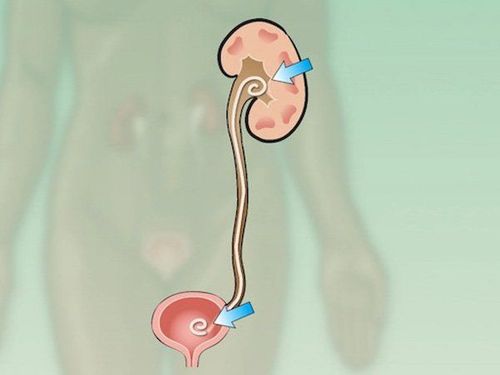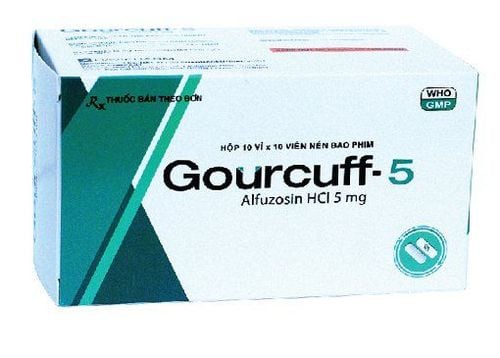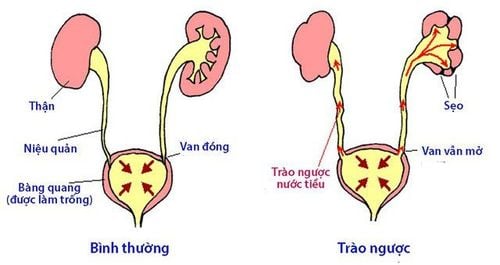This is an automatically translated article.
The article is professionally consulted by MSc, BS. Dang Manh Cuong - Doctor of Radiology - Department of Diagnostic Imaging - Vinmec Central Park International General Hospital.Ureteral stenosis is a common clinical complication, patients may experience ureteral stenosis in many different diseases or after interventions in the urinary tract. Ureteral stenting under enhanced radiographs is one of the effective solutions to narrowing, often performed in conjunction with surgical repair or dilation of the lumen of the ureter.
1. The phenomenon of ureteral stenosis
The ureter is a retroperitoneal muscular tube, lined by transitional epithelium, that connects the renal pelvis to the bladder. The average length of the ureter is 20 to 30 cm, which varies depending on the height of the person. Ureteral stenosis is a narrowing of the lumen of the ureter causing obstruction and dysfunction of the urinary system. The most common site of ureteral stricture is ureteral junction stenosis which can be congenital or acquired. Analysis of cases of ureteral stenosis revealed disturbances in collagen deposition, fibrosis, and inflammation, which varied depending on the cause of the ureteral stricture.Anemia leading to fibrosis is a common cause of ureteral stricture. Less common causes are related to mechanical factors such as following surgical sutures of the ureter. The widespread use of upper ureteroscopy increases the risk of ureteral stricture. Many previous studies have shown that ureteral stricture accounts for about 3% to 11% of patients treated with urolithiasis. Recent studies performed on more advanced techniques such as endoscopy with smaller tubes or less traumatic devices have found this incidence to be less than 1%.
Urethral stricture is also a complication of kidney transplant surgery, accounting for 3 to 8%. Pelvic and gynecological surgeries are also considered causes of ureteral stricture.
Some patients with ureteral stricture are asymptomatic, others present with urinary disturbances or experience severe renal colic. The severity of symptoms did not correlate with the degree of obstruction. A severe obstruction may not present any clinical symptoms.
Chronic ureteral stricture often leads to urinary tract obstruction, asymptomatic dilatation of the ureter above the stricture, and hydronephrosis. The most serious complication of ureteral stricture is complete obstruction of the urinary tract and loss of renal function or renal failure. Therefore, after being diagnosed, ureteral stricture should be treated as soon as possible to preserve kidney function.

Ghép thận có thể là nguyên nhân gây hẹp niệu quản
2. Indications/Contraindications for placing ureteral stents under enhanced radiographs in any case
Ureteral stenting under enhanced radiographs is chosen to resolve bladder stenosis when retrograde ureteral stenting has failed. Retrograde ureteral stenting is often preferred because of its minimally invasive nature but is not always successful and requires expensive endoscopic systems. Ureteral stenting under enhanced radiographs is often performed in conjunction with percutaneous ureteral dilation and repair, increasing the possibility of restoring urinary tract flow.Indications for ureteral stenting under enhanced radiography include:
Ureteral stenosis failed with endoscopic ureteral stenting After an injury that damaged the ureter After surgical repair and reconstruction of the ureter After performing an endoscopic retrograde ureteroscopy Prepare for percutaneous or extracorporeal lithotripsy. Ureteral stenting under enhanced radiograph has the following contraindications:
Urinary incontinence, urinary incontinence Small size bladder or diverticulum, Acute pyelonephritis or infection of bladder or urethra Acute bleeding from the urinary system

Bệnh nhân có bàng quang nhỏ chống chỉ định thực hiện
3. Procedure for placing ureteral stents under enhanced X-ray
Placement of a ureteral stent under an enhanced radiograph should follow the following steps:Prepare an X-ray machine and accompanying protective equipment Prepare drugs such as contrast media, anesthetics, and anesthetics if available prescription, anaphylaxis treatment kit, and medical supplies including syringes of all kinds, gloves, caps, bandages, gauze, JJ ureteral catheter, drainage catheter... Patient does not eat What to drink about 6 hours before the procedure. Thorough examination before implementation to rule out contraindications. Place the patient in a supine or prone position. Disinfect the skin that needs intervention. Carrying out percutaneous pyelonephritis catheterization, injecting contrast medium through the catheter to survey the shape of the renal pelvis and ureter, thereby determining the location and assessing the degree of obstruction. Insert the lead into the renal pelvis following the path of the catheter, then withdraw the drainage catheter. Continue to insert the ureteral stent or JJ tube to the ureter and bladder through the inlet from the renal pelvis, then withdraw the lead. The two curved ends of the ureter should be placed inside the bladder lumen and inside the renal pelvis. Place a catheter to drain the renal pelvis through the skin. This catheter will be removed after approximately 48 hours with a well-circulated ureteral stent. Inject the contrast agent and observe under the magnifying X-ray screen, determine the position of the ureteral stent and the urinary tract through the stent.

Nhiễm trùng huyết có thể xảy ra sau khi thực hiện thủ thuật
4. Management of possible complications after placing ureteral stents under enhanced x-ray
After placing ureteral stents under enhanced X-ray, patients may experience complications such as:Infection: Infection can occur in the outer skin, urinary system infection or more seriously, sepsis . When the infection is localized, it is necessary to change the dressing daily and keep the wound clean. Urinary tract infections require medical treatment and pyelonephritis purulent drainage if necessary. When sepsis occurs, the patient should be admitted to the intensive care unit for treatment and close monitoring. Bleeding: Bleeding complications can be detected by the presence of a retroperitoneal mass if there is retroperitoneal bleeding or hematuria if there is urinary tract bleeding. Usually, the patient will be monitored. , the site of bleeding can stop on its own. If the blood loss does not improve, the patient should be taken to the intervention room for management. Vinmec International General Hospital with a system of modern facilities, medical equipment and a team of experts and doctors with many years of experience in medical examination and treatment, patients can rest assured to visit. and hospital treatment.
Before taking a job at Vinmec Central Park International Hospital from December 2017, Doctor Dang Manh Cuong has over 18 years of experience in the field of ultrasound - diagnostic imaging in Transport Hospitals. Hai Phong, MRI Department of Nguyen Tri Phuong Hospital and Diagnostic Imaging Department of Becamex International Hospital.
To register for examination and treatment at Vinmec International General Hospital, you can contact Vinmec Health System nationwide, or register online HERE.
MORE
What is a urological examination? What is vesicoureteral reflux? Diagnosis and treatment of vesicoureteral reflux














